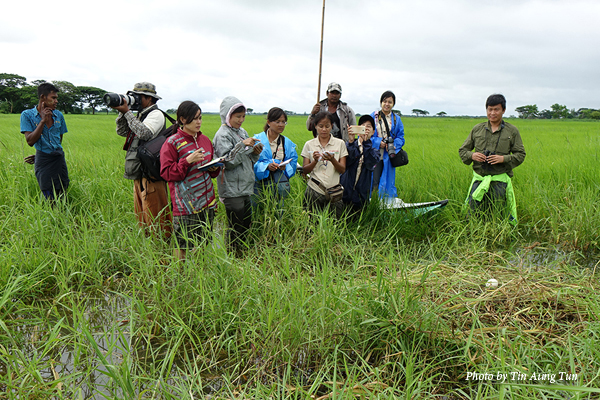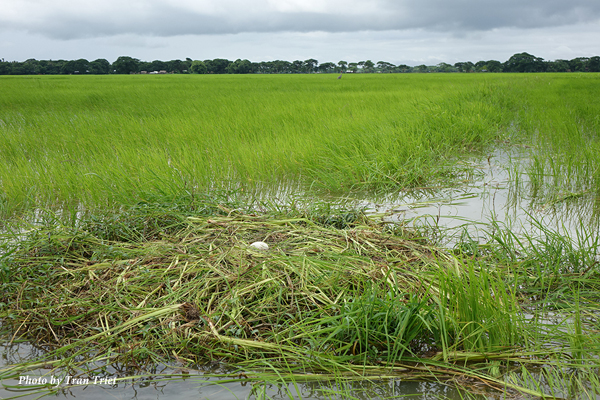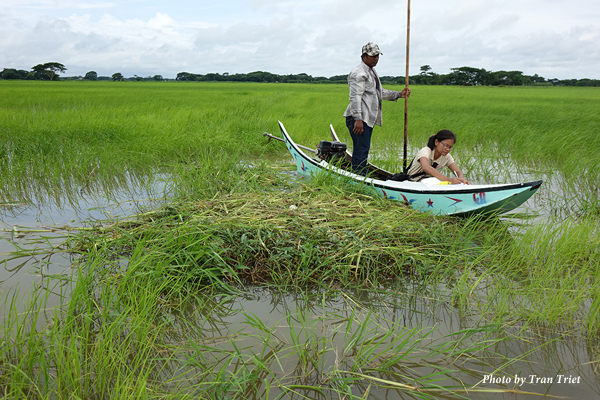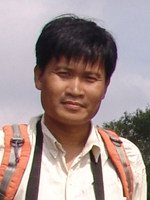
July in the Ayeyarwady Delta in southern Myanmar, monsoonal storms brought endless rains. Water fell from the sky continuously, day and night. Pouring showers, torrential at times, were interspersed with periods of light rain and drizzle. The constant rain did not pause daily activities. Farmers worked hard on paddy fields, tending their main rice crop of the year.
Joining the farmers on the fields were pairs of Sarus Cranes, busily building their nests at the start of the breeding season. The cranes’ nests were built mostly with the rice plants the farmers had just transplanted on their fields! Most Burmese farmers seemed not to care much about these small troubles. Many of them, in fact, love to have cranes on their fields. In Wisconsin a great man called it “land ethic.” In Myanmar farmers do not have a title for that attitude. It’s just part of their life.

I joined the Myanmar Crane Team on one of their survey trips to monitor Sarus Crane breeding success in the Ayeyarwady Delta. Last year, the team located 78 crane sites, 21 of which were nesting. This year, they will visit each nest site frequently to record data on breeding activities. Within three field days we visited seven active nests, two of them already had eggs. The rice paddies where the cranes chose to nest often have small natural wetlands. Most of these paddies are rain-fed, planted with only one crop of rice per year. The number of agricultural chemicals used is also low, allowing a healthy aquatic environment that provides plenty of food items for parent cranes to feed their fast-growing chicks.


We returned to Yangon, Myanmar, to meet with managers and engineers of the Integrated Ayeyarwady Delta Strategy Project (IADS), a Netherlands-funded initiative helping Myanmar to develop a vision and a strategy for developing the Ayeyarwady Delta. We talked about a future of the Delta of which the Sarus Crane is a part. We proposed that the Sarus Crane as one of the indicators of a “safe, prosperous and sustainable” (IADS’ motto) Ayeyarwady Delta. The Myanmar Crane Team will take IADS engineers with them on their coming field surveys, and IADS will invite the Myanmar Crane Team to their consultancy meetings.
Upon returning to Saigon, Vietnam, I went directly to Phu My, a site in southwest Vietnam where we are working with communities to protect Sarus Crane habitat. Traveling across the Mekong Delta with fresh memories of the Ayeyarwady Delta, I could see how much intensive agriculture had reduced the diversity of life on agricultural landscape. Let’s hope that what happened in the Mekong will not be repeated in the Ayeyarwady.
Safe lands, cranes dance.
P.S. Look carefully at the photos to see if you can find mama crane!
 Story submitted by Dr. Tran Triet, Southeast Asia Program Coordinator for the International Crane Foundation. Click here to learn more about our work in South/Southeast Asia.
Story submitted by Dr. Tran Triet, Southeast Asia Program Coordinator for the International Crane Foundation. Click here to learn more about our work in South/Southeast Asia.
